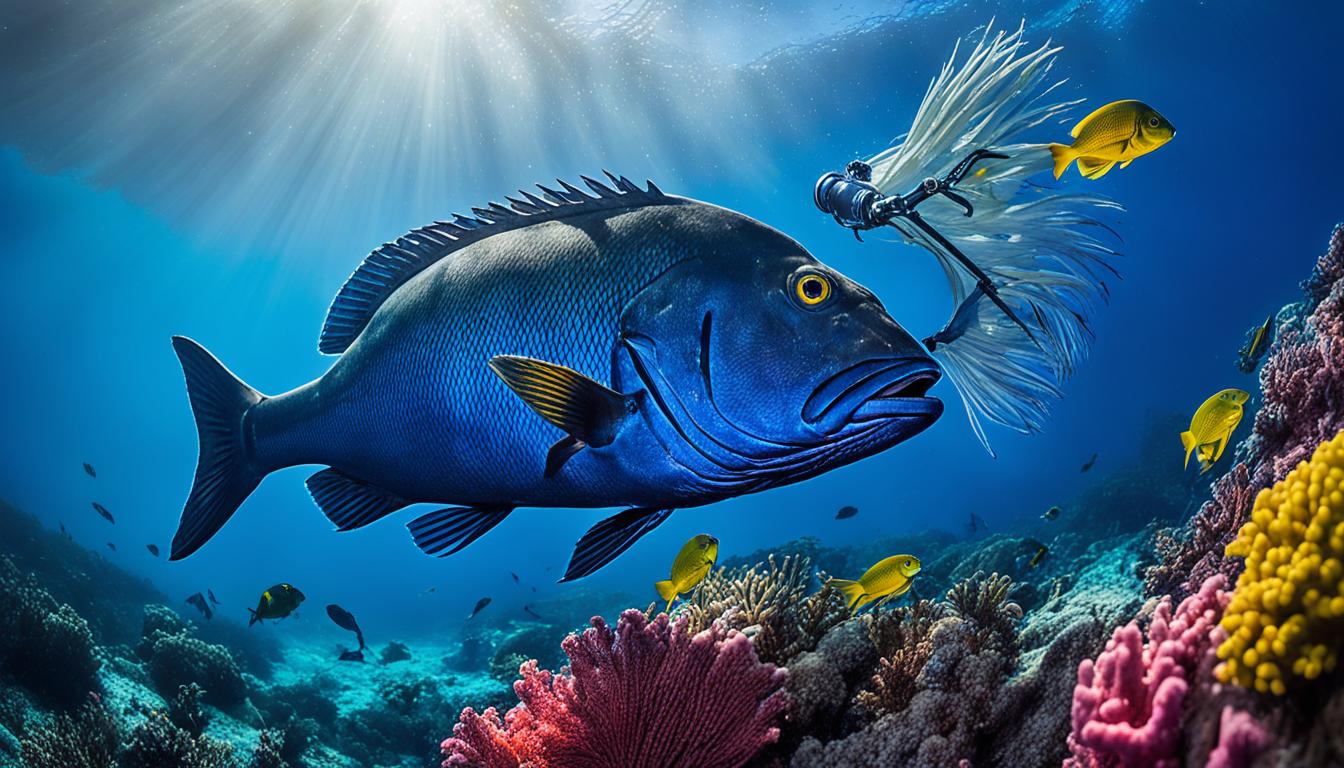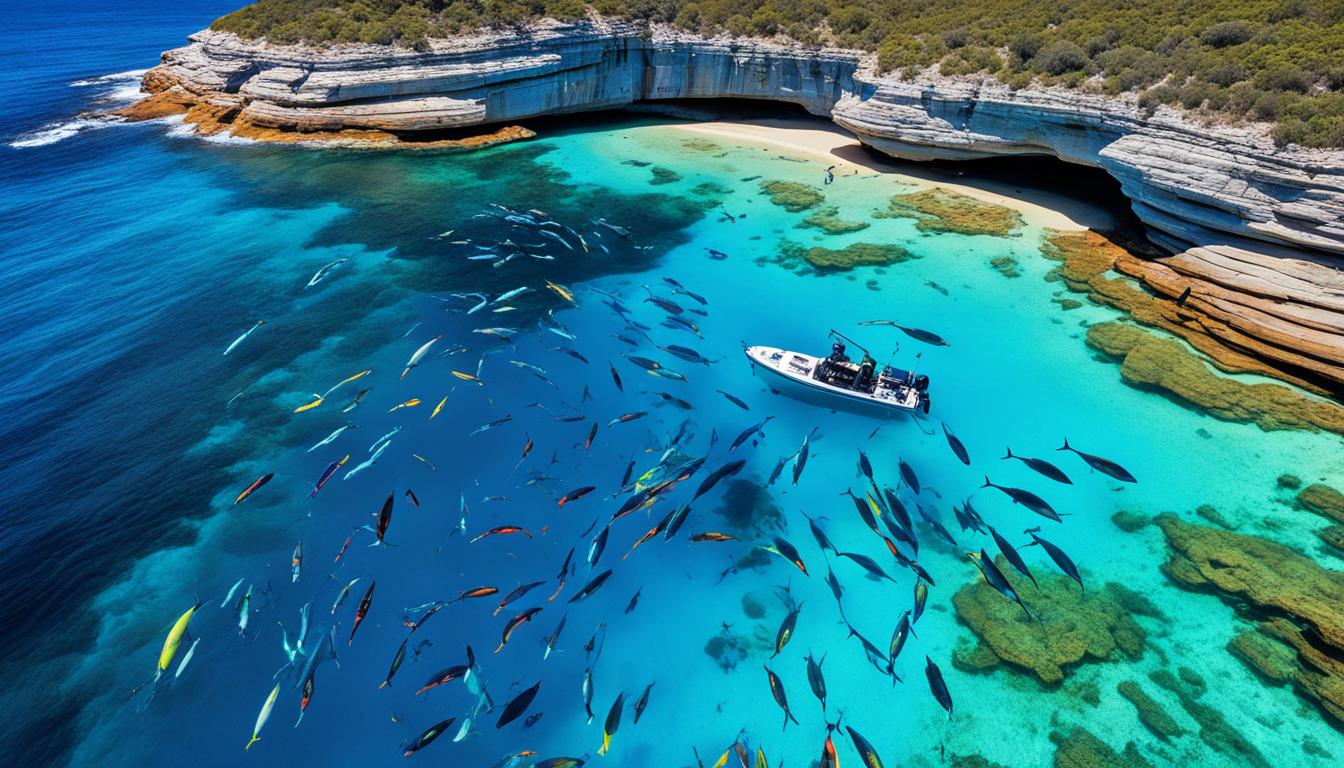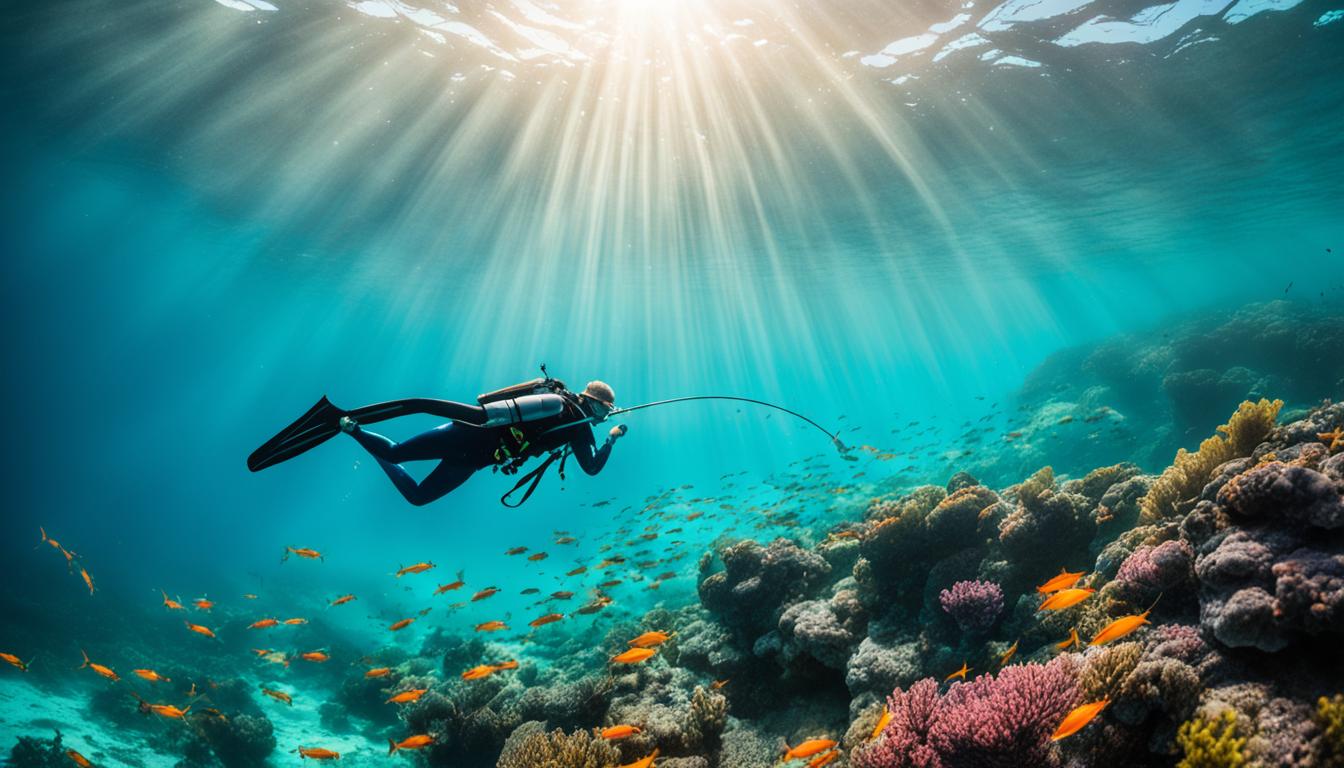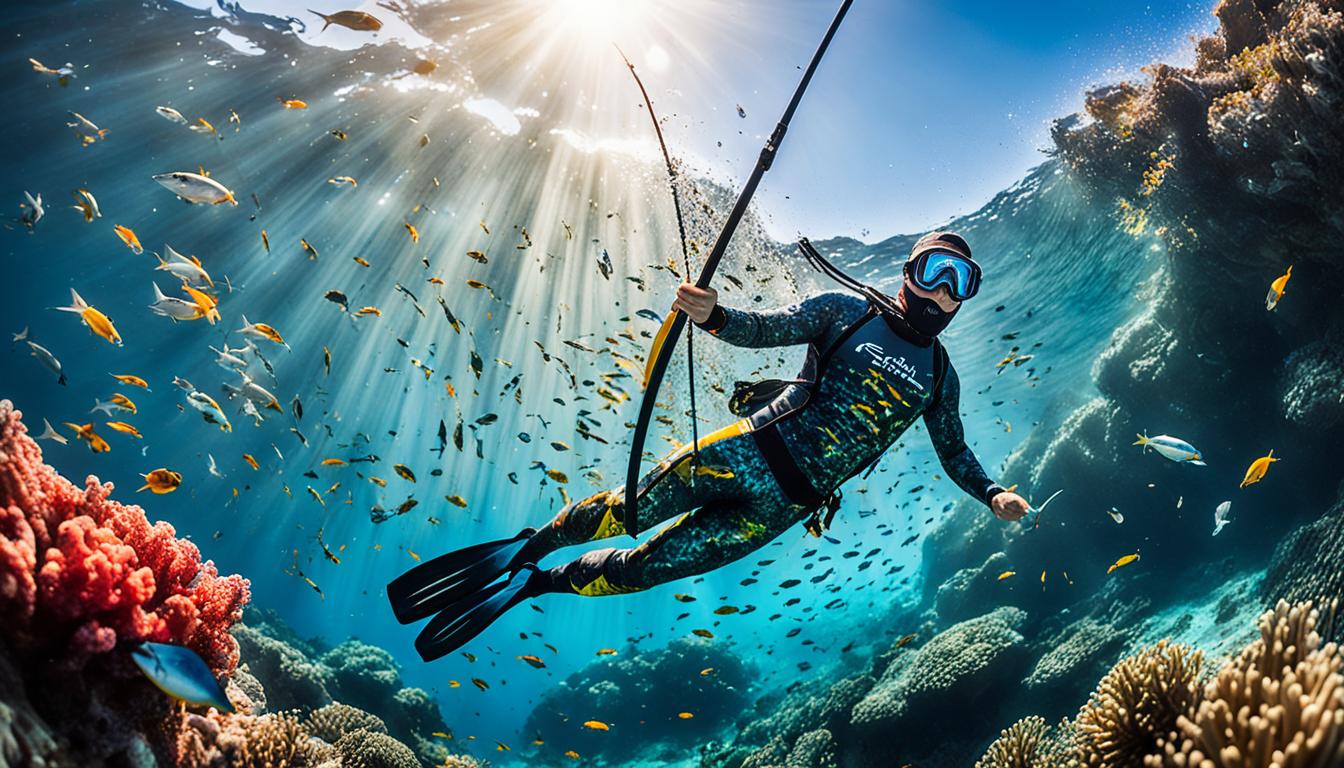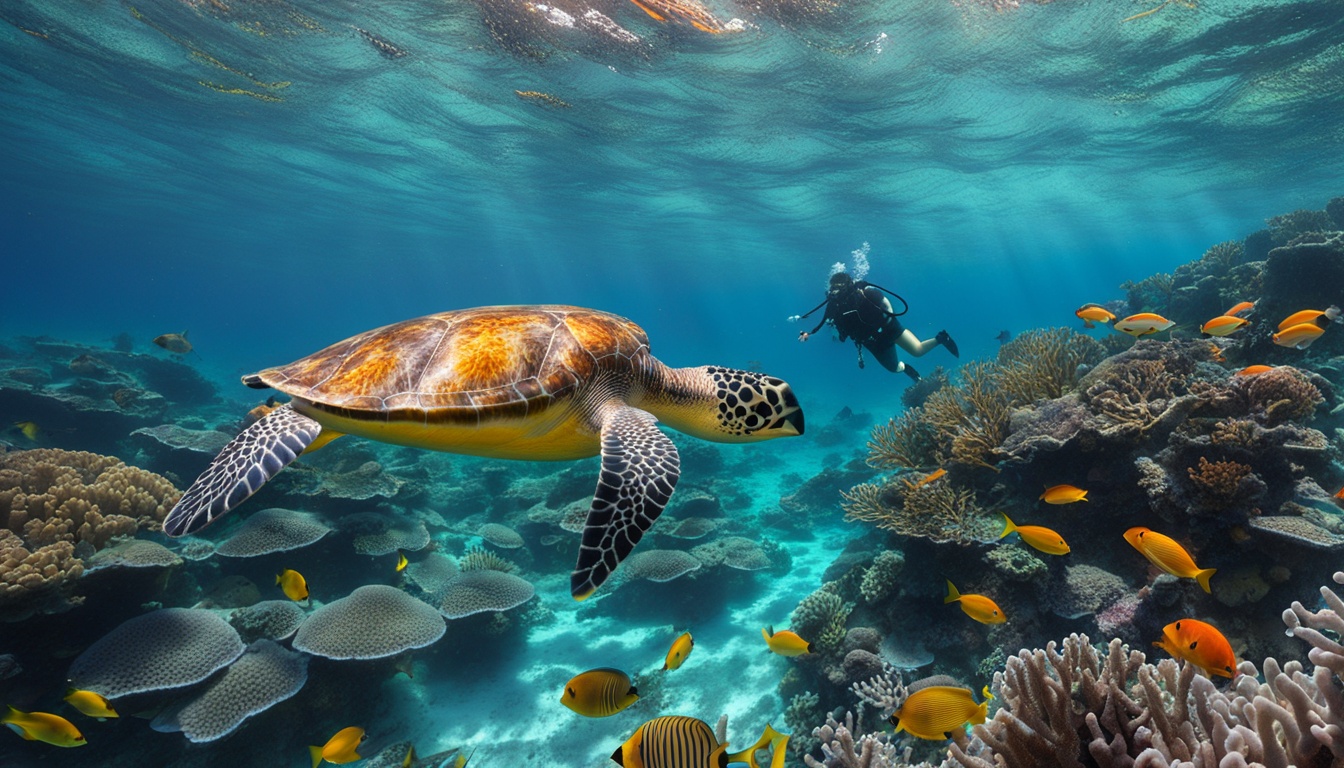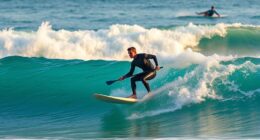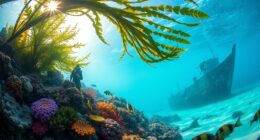Imagine plunging into crystal-clear waters, surrounded by a kaleidoscope of vibrant marine life. As you descend deeper, the exhilaration builds, knowing that you’re about to embark on a thrilling underwater hunting experience like no other. Welcome to the world of blue groper spearfishing!
Blue groper spearfishing combines the adrenaline-inducing sport of diving with the excitement of hunting underwater. Whether you’re a seasoned spearfisher or a beginner looking for a new adventure, this activity allows you to immerse yourself in the fascinating world beneath the waves while testing your skills in sustainable spearfishing techniques.
Blue gropers, with their stout bodies and peg-like teeth, are a remarkable species found in the waters of southeastern Australia, particularly in New South Wales and the Great Southern Reef. Their stunning coloration and impressive size make them a sought-after target for spearfishers seeking the ultimate underwater challenge. The Western Blue Groper, the largest of the blue groper species, can grow up to a maximum length of 1.7 meters and weigh a whopping 40 kilograms!
But blue groper spearfishing isn’t just about the thrill of the hunt. It’s also about appreciating the unique characteristics of these fascinating creatures and understanding their role in maintaining marine ecosystem balance. Blue gropers act as keystone species, controlling the population of sea urchins and other reef organisms. They rely heavily on sea urchins as a primary food source, showcasing their specialization in regulating sea urchin populations.
To ensure the preservation of blue gropers and their habitats, conservation efforts have been put in place. Fishing restrictions, including spear prohibition, and the establishment of marine protected areas are essential in safeguarding these vulnerable species. Responsible diving practices play a vital role in protecting blue gropers as well. Their friendly and approachable behavior towards divers underlines the need for responsible and sustainable interactions.
Key Takeaways:
- Blue groper spearfishing combines the thrill of diving with the excitement of hunting underwater.
- Blue gropers are a remarkable species found in southeastern Australia, known for their vibrant coloration and impressive size.
- Blue gropers play a crucial role in maintaining marine ecosystem balance by controlling the population of sea urchins and other reef organisms.
- Conservation efforts, including fishing restrictions and marine protected areas, are in place to safeguard blue groper populations.
- Responsible diving practices are crucial for protecting blue gropers and fostering sustainable interactions between divers and these captivating creatures.
The Fascinating World of Blue Gropers
Blue gropers are a remarkable species of fish found in the waters of southeastern Australia, particularly in New South Wales and the Great Southern Reef. Their distinct characteristics and vibrant coloration make them a sought-after sight for blue groper spearfishing enthusiasts.
With their stout bodies and peg-like teeth, blue gropers are easily recognizable. These mesmerizing creatures thrive in exposed rocky reef environments, making them a delight to encounter during underwater excursions.
However, it’s crucial to engage in sustainable spearfishing practices to ensure the preservation of blue groper populations. Overfishing and pollution pose significant threats to these magnificent fish and their reef ecosystems. By practicing responsible spearfishing techniques, such as proper catch limits and selective targeting, we can contribute to their conservation.
When embarking on a blue groper spearfishing adventure, it’s essential to explore the best spearfishing spots. Along the southeastern coast of Australia, from southern Queensland to Wilson’s Promontory in Victoria, you’ll find ideal locations to encounter these captivating creatures. The rocky reefs provide a rich and diverse environment that supports the thriving blue groper populations.
Conservation of Blue Gropers
Blue gropers play a critical role in maintaining the ecological balance of their reef ecosystems. They control populations of crabs, prawns, shellfish, and sea urchins, preventing overgrowth that can negatively impact the delicate reef habitat.
Blue Gropers can live up to 70 years, allowing them to establish themselves as key players in their marine environments. Their longevity and ecological impact emphasize the need for sustainable spearfishing practices.
Efforts to protect blue gropers from overfishing have been implemented, with specific fishing restrictions in place to safeguard these vulnerable species. In New South Wales, spearfishing of Eastern Blue Gropers is prohibited, while angling is permitted with strict bag limits. Southern Australia also enforces bag limits for Western Blue Gropers, preventing excessive exploitation.
| State | Regulation |
|---|---|
| New South Wales | Prohibition of spearfishing for Eastern Blue Gropers, angling permitted with bag limits |
| South Australia | Personal daily bag limit of 1 fish allowed for Western Blue Gropers (60-100cm) |
| Victoria | Prohibition of taking or possessing Blue Gropers by recreational fishers |
| Western Australia | Daily bag limit of 1 fish over 50cm for Western Blue Gropers |
The conservation efforts put into place have proven to be effective in stabilizing blue groper populations. Since the spearfishing ban in New South Wales waters in 1969, their numbers have rebounded, ensuring their ongoing presence in the region.
The Evolutionary Story
The separation of Eastern and Western Blue Gropers can be traced back to the Ice Age. Geographical separation caused by this natural event led to the development of distinct species. Eastern Blue Gropers established themselves along the southeastern coast, while Western Blue Gropers inhabit the waters of southern and southwest Australia.
Their evolutionary path has shaped their characteristics and habitats, showcasing the wonders of nature’s adaptation and diversification process.
Exploring the fascinating world of blue gropers through spearfishing grants enthusiasts a unique opportunity to witness their beauty and contribute to their conservation. By practicing sustainable spearfishing techniques and respecting fishing regulations, we can ensure the continued presence of these remarkable creatures in our oceans.
The Life Cycle of Blue Gropers
Blue gropers undergo a fascinating life cycle, starting as females and potentially transitioning into males later in life. The eastern blue groper is an iconic species found in New South Wales, while the western blue groper can be found along the Great Southern Reef. Understanding the life cycle of blue gropers is crucial for blue groper spearfishing enthusiasts to appreciate the unique characteristics of these fish.
From Female to Male: A Remarkable Transformation
In the early stages of their lives, blue gropers are typically female. However, as they grow older and larger, some individuals have the ability to change their sex and become males. This phenomenon, known as protogyny, is an intriguing aspect of their life cycle. It is believed that this sex transformation occurs in response to changes in social dynamics and breeding opportunities within the blue groper population.
The life cycle of blue gropers showcases their incredible adaptability and resilience as they navigate the challenges of their underwater world.

The transition from female to male generally occurs when the blue groper reaches a certain size and age. As a male, their appearance undergoes a dramatic transformation. Males exhibit vibrant colors, ranging from deep navy to cobalt blue, which helps them attract mates and establish dominance in their territory. Females and juveniles, on the other hand, display more subdued hues, with brown to green or reddish-brown coloration.
Spawning and Recruitment: A Winter Journey
The life cycle of blue gropers involves a fascinating process of spawning and recruitment. Spawning typically occurs during the winter months, from July to October, when the waters are cooler. Female blue gropers release their eggs into the water, where they are fertilized by male blue gropers. The fertilized eggs then develop into larvae, embarking on a perilous journey.
During the early stages of their lives, blue groper larvae depend on oceanic currents to carry them to suitable habitats. The young blue gropers primarily recruit into estuarine seagrass beds during winter, where they find ample food resources and protection from predators. These seagrass habitats serve as crucial nurseries for the development of young blue gropers, providing them with the necessary environment to grow and thrive.
Protection and Conservation Efforts
The discovery and understanding of the life cycle of blue gropers have highlighted the ecological significance of these fascinating fish. Their importance in maintaining the balance of marine ecosystems underscores the need for conservation efforts and protection measures.
In response to spearfishing pressure and concerns over the depletion of blue groper populations, strict regulations have been implemented to protect these iconic species. Spearfishing of blue gropers is prohibited in New South Wales and restrictions are in place in other regions, such as Victoria and Western Australia. Additionally, initiatives like the ban on bottom-set gill nets and the prohibition of blue groper sale aim to safeguard their populations and habitats.
Understanding and respecting the life cycle of blue gropers play a vital role in ensuring their long-term survival and the preservation of the marine ecosystems they inhabit.
The Two Blue Groper Species: Eastern and Western
Blue gropers are endemic to Australia, with two closely related species – the eastern blue groper and the western blue groper. The separation of these species can be traced back to the Ice Age, with the movement of temperate waters. Eastern blue gropers are found in coastal, marine waters from southern Queensland to Wilson’s Promontory in Victoria, while western blue gropers can be found along the Great Southern Reef.
Their distribution and distinct characteristics contribute to the rich biodiversity of Australia’s marine ecosystems. However, both species face threats from fishing and overexploitation. Recognizing the importance of sustainable fishing practices and conservation efforts is crucial for protecting the future of blue gropers and the fragile ecosystems they call home.
The Role of Blue Gropers in Marine Ecosystems
Blue gropers play a critical role in maintaining the balance of marine ecosystems. These magnificent fish are not only a sight to behold during blue groper spearfishing adventures, but they also contribute to the overall health and stability of the underwater world.
One of the key contributions of blue gropers is their control over the sea urchin population. Sea urchins can sometimes multiply rapidly, leading to the overconsumption of algae and other reef organisms. This can disrupt the delicate balance of the marine ecosystem. However, blue gropers feed on sea urchins, keeping their population in check and preventing overgrowth.
By regulating the sea urchin population, blue gropers indirectly benefit other marine species. They help maintain the health and availability of food sources such as crabs, prawns, shellfish, and other small organisms that rely on a healthy ecosystem for survival.
The relationship between blue gropers and sea urchins is a perfect example of nature’s interconnectedness. Without blue gropers, the sea urchin population could skyrocket, leading to the overgrazing of algae and the potential collapse of entire reef systems.

Conservation efforts for blue gropers, including fishing restrictions such as spear prohibition and the establishment of marine protected areas, are crucial in preserving their populations and ensuring the balance of marine ecosystems. Overfishing and pollution pose significant threats to blue gropers, underscoring the importance of sustainable practices in blue groper spearfishing and marine conservation.
By understanding and appreciating the pivotal role that blue gropers play in maintaining marine ecosystems, we can develop a deeper respect for these remarkable creatures and work towards their long-term conservation. Safeguarding their populations means safeguarding the health and vitality of our precious underwater world.
Gear and Techniques for Blue Groper Spearfishing
When it comes to blue groper spearfishing, having the right gear and mastering effective techniques is essential. The primary tool of the trade is the speargun, which comes in various types including pneumatic and band-powered spearguns. These powerful weapons provide the accuracy and range needed to target blue gropers and other fish species.
Stealth and patience are crucial skills to develop when approaching blue gropers underwater. These intelligent creatures have sharp senses and can easily detect sudden movements. Slowly and quietly maneuvering through the water will increase your chances of getting close enough for a successful shot.
Understanding the underwater topography is also important. Blue gropers are known to inhabit rocky areas, underwater caves, and reefs. By familiarizing yourself with their preferred habitats, you can strategize and position yourself in the right spots, increasing your chances of encountering these magnificent fish.
Using decoys or lures can also be a useful technique in blue groper spearfishing. These tools can attract blue gropers by mimicking their natural prey or creating curiosity. Properly deploying and utilizing decoys can make your presence more alluring and increase the likelihood of a successful catch.

Of course, having the right gear goes beyond just the speargun. Blue groper spearfishing requires a range of equipment, including masks, snorkels, fins, wetsuits, weight belts, gloves, knives, dive computers, and weaponry options like Hawaiian slings, pole spears, and spearguns. Each piece of gear is designed to enhance your comfort, safety, and success in the water.
When it comes to wetsuits, the choice of thickness depends on the water temperature. In warm waters, a wetsuit between 0.5 and 1.5 mm is suitable, while colder temperatures may require a thicker wetsuit of 2 or 3 mm. It’s important to choose a wetsuit that provides insulation without restricting your movement.
Safety provisions are crucial in spearfishing due to the inherent dangers of the sport, including possible drownings, shark attacks, and other risks. Diving with a buddy or a group is advisable to enhance safety and provide assistance in case of emergencies. Additionally, using a “diver down” flag is essential to alert other boats of divers in the water, minimizing the risk of accidents.
By equipping yourself with the right gear and mastering effective techniques, you can embark on thrilling blue groper spearfishing adventures and increase your chances of a successful catch.
Conservation of Blue Gropers
Conservation efforts play a crucial role in safeguarding the survival of blue gropers and their habitats. The fishing restrictions put in place, including the prohibition of spearfishing, have been instrumental in protecting these vulnerable species. Furthermore, the establishment of marine protected areas has provided a safe haven for blue groper populations to thrive.
Blue groper spearfishing enthusiasts have an essential role to play in conservation. By understanding and adhering to fishing restrictions, they can contribute to the preservation of these magnificent creatures.
Fishing Restrictions
Spearfishing of Eastern Blue Gropers has been prohibited in New South Wales (NSW) waters since 1969. This important regulation aims to prevent the decline of blue groper populations due to spearfishing activities.
In NSW, anglers are allowed to fish for blue gropers with a bag limit of two fish over 30cm, and only one fish is allowed to be over 60cm. This measure ensures that fishing is sustainable and helps maintain healthy blue groper populations in the region.
Similarly, Victoria prohibits the taking or possession of Eastern Blue Gropers by recreational fishers, recognizing the importance of protecting these species.
Western Blue Gropers, classified as Vulnerable by the International Union for Conservation of Nature (IUCN), also face overexploitation issues. To protect Western Blue Gropers, fishing restrictions have been implemented in various regions.
In Western Australia, there is a daily bag limit of one fish over 50cm permitted for Western Blue Gropers. Victoria also prohibits taking or possessing of Western Blue Gropers by recreational fishers, emphasizing the need for conservation.
South Australia permits a personal daily bag limit of one fish for Western Blue Gropers measuring between 60-100cm, ensuring responsible fishing practices.
Marine Protected Areas
Marine protected areas have been established to safeguard blue groper populations and their habitats. These protected zones provide a sanctuary where blue gropers can thrive undisturbed, contributing to the overall health and biodiversity of marine ecosystems.
Blue groper spearfishing enthusiasts should be aware of the boundaries and regulations within marine protected areas. By respecting these areas, they can help ensure the long-term survival of blue gropers and the preservation of their natural habitats.
| Conservation Measures | Impact |
|---|---|
| Fishing restrictions, including spear prohibition | Protects vulnerable blue groper populations and prevents overexploitation |
| Establishment of marine protected areas | Safeguards blue groper habitats and contributes to the overall health of marine ecosystems |
Blue gropers are essential keystone species in maintaining the health and balance of reef ecosystems. Their disappearance would have a disastrous impact on marine biodiversity and ecosystem stability. Therefore, it is crucial that blue groper spearfishing enthusiasts actively participate in the conservation efforts to protect these magnificent creatures for future generations to enjoy.

The Unique Interaction between Blue Gropers and Divers
One of the most remarkable aspects of blue groper spearfishing is the unique interaction between these captivating fish and divers. Blue gropers are known for their friendly and approachable behavior towards divers, adding an extra level of excitement to underwater adventures.
When encountering a blue groper, you may find yourself face-to-face with a stunning creature adorned in vibrant colors. The Eastern blue groper, endemic to New South Wales, undergoes a fascinating color transition, with adult males displaying a mesmerizing cobalt blue coloration, while adult females possess a beautiful reddish-brown hue. It’s a truly breathtaking sight.
As you explore the underwater world, it’s important to remember that responsible diving practices are essential in maintaining a harmonious relationship with these incredible creatures. Blue gropers play a crucial role in maintaining the ecological balance of their habitats, feeding on sea urchins and controlling their population. By respecting their habitat and behavior, you contribute to their well-being and long-term survival.

Blue groper spearfishing provides an opportunity for divers to witness the unique behaviors and interactions of these fascinating creatures. It’s a chance to engage with the underwater world and gain a deeper appreciation for the delicate balance of marine ecosystems.
To ensure the continued well-being of blue gropers, it’s crucial to raise awareness about the threats they face and spread the word about responsible diving practices. By promoting conservation efforts and actively participating in sustainable spearfishing, divers can actively contribute to the protection of these remarkable fish.
Conservation of Blue Gropers
The conservation of blue gropers involves various measures to safeguard their populations and preserve their habitats. Fishing restrictions, including the prohibition of spearfishing, have been implemented to mitigate the risk of overfishing and population decline. Additionally, the establishment of marine protected areas creates safe havens for blue groper populations to thrive.
By actively supporting conservation efforts and adhering to responsible fishing practices, divers can play a crucial role in protecting blue gropers for future generations to enjoy.
Furthermore, education and awareness initiatives are vital to ensure the long-term survival of blue gropers. By spreading knowledge about the importance of these magnificent fish and their impact on marine ecosystems, we can inspire others to join the cause and actively contribute to their conservation.
Responsible Diving Practices
Responsible diving practices are essential when interacting with blue gropers and their habitats. Here are some key guidelines to follow:
- Do not disturb or chase blue gropers: Observe from a respectful distance and allow them to go about their natural behavior.
- Avoid touching or feeding blue gropers: It’s crucial to maintain a hands-off approach and refrain from providing them with any food. This ensures their natural feeding habits are not disrupted.
- Respect marine protected areas: Stay informed about designated protected areas and abide by the regulations in place to safeguard blue groper populations.
By adhering to these responsible diving practices, you can establish a positive and mutually beneficial relationship with blue gropers while actively contributing to their conservation.
Conservation Measures for Blue Gropers
| Conservation Measures | Description |
|---|---|
| Fishing restrictions | Prohibition of spearfishing and implementation of size and bag limits to prevent overfishing. |
| Marine protected areas | Establishment of protected zones to provide safe habitats for blue groper populations. |
| Conservation awareness | Education initiatives to raise awareness about the importance of blue gropers and their conservation needs. |
Implementing these conservation measures is crucial to ensure the long-term survival of blue gropers and maintain the delicate ecological balance of their habitats. By practicing responsible diving and actively supporting conservation efforts, you can contribute to the preservation of these magnificent fish and the underwater world they call home.
Wreck Spearfishing: Exploring the Depths
Experience the thrill of wreck spearfishing in the breathtaking waters surrounding Islamorada, located in the stunning Florida Keys. As a spearfisher, you have the opportunity to embark on an adventure like no other, diving around sunken ships and artificial structures that serve as habitats for a wide variety of fish species. Whether you’re a seasoned spearfishing enthusiast or a beginner looking to explore the depths, Islamorada, often referred to as the “Sportfishing Capital of the World,” provides the perfect backdrop for an exhilarating and memorable experience.
At the heart of wreck spearfishing is the chance to encounter an array of fish species that call these artificial reef systems home. From the sought-after Hogfish and Grouper to pelagic species like Mahi-Mahi, Tuna, and Sailfish, the waters of the Florida Keys offer an abundance of marine life waiting to be discovered and captured with your speargun.

Safety is a top priority when it comes to wreck spearfishing. Experienced and knowledgeable crews are dedicated to ensuring that you have the necessary gear and expertise for a successful and enjoyable dive. Whether you opt for a freedive charter, which can accommodate up to four divers with six passengers on board, or a scuba charter with the additional option of nitrox for an enhanced diving experience, you can rest assured that your safety and satisfaction are in capable hands.
As you embark on your wreck spearfishing adventure, it’s important to note that the Florida Keys are a protected area with specific rules governing spearfishing. Responsible spearfishing practices, such as selective fishing, avoiding overfishing, and respecting protected areas, are crucial to ensure the sustainability and preservation of the marine life that calls these waters home.
Planning and preparation are key to a safe and successful wreck spearfishing expedition. Before setting off on your adventure, it’s essential to educate yourself about local regulations and regulations, gear up with the right equipment, and have a comprehensive understanding of the marine ecosystem you’ll be exploring. By doing so, you’ll not just have an unforgettable experience but also play a vital role in the conservation of the Florida Keys’ marine life.
To book your wreck spearfishing trip in Islamorada, simply call 305-680-8879. Don’t miss out on the opportunity to combine the thrill of spearfishing with the captivating world of sunken wrecks. Dive into the depths and unlock the wonders that await you in the beautiful Florida Keys.
Conclusion
Blue groper spearfishing and wreck spearfishing offer thrilling and rewarding experiences that allow you to immerse yourself in the fascinating underwater world. By practicing sustainable spearfishing techniques and following fishing regulations, you can play a crucial role in conserving blue groper populations and maintaining the health of marine ecosystems. Whether you’re exploring the vibrant waters of southeastern Australia or diving in the captivating Florida Keys, the excitement of blue groper spearfishing and wreck spearfishing should be treasured and safeguarded.
Blue gropers, with their unique life cycle and role as keystone species, are vital for the balance of marine ecosystems. As the fish emblem of New South Wales, the separation of Western and Eastern Blue Gropers during the Ice Age has shaped their distribution along the coasts. These remarkable creatures predominantly feed on sea urchins, crabs, prawns, and shellfish, contributing to the regulation of marine species’ population and ecosystem balance.
It’s essential to be equipped with the right gear and knowledge when engaging in blue groper spearfishing or wreck spearfishing. By using reliable spear guns, sturdy fins, durable wetsuits, and weights to counteract buoyancy, you can enhance your chances of a successful dive. Pneumatic spear guns, known for their ease of use and low maintenance, are popular among spearfishers. Understanding underwater topography, employing decoys and lures, and adhering to responsible spearfishing practices also contribute to a sustainable and enjoyable experience.
As a spearfishing enthusiast, you have the power to actively participate in marine conservation efforts. By respecting fishing restrictions, adhering to size and catch limits, and engaging in habitat restoration projects and beach clean-ups, you can contribute to the preservation of the ocean ecosystem. Sharing your knowledge and skills through workshops, seminars, and online forums can further promote ethical spearfishing practices and conservation principles within the spearfishing community. Together, we can ensure the long-term sustainability and protection of blue gropers and the beauty they bring to our underwater world. Additionally, supporting or even organizing a spearfishing course to explore oceans responsibly can inspire others to learn about sustainable fishing techniques and the importance of maintaining healthy marine habitats. By fostering a community focused on ethical spearfishing, we can help future generations appreciate and protect the delicate balance of life beneath the waves.

